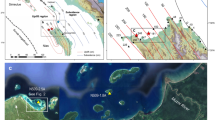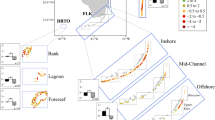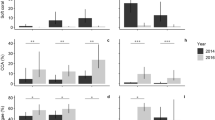Abstract
The effect of European settlement on water quality in the Great Barrier Reef of Australia is a long-standing and controversial issue1,2,3,4,5,6. Erosion and sediment transport in river catchments in this region have increased substantially since European settlement6,7,8,9,10, but the magnitude of these changes remains uncertain1,2,3,4,5,6,7,8,9,10. Here we report analyses of Ba/Ca ratios in long-lived Porites coral from Havannah Reef—a site on the inner Great Barrier Reef that is influenced by flood plumes from the Burdekin river—to establish a record of sediment fluxes from about 1750 to 1998. We find that, in the early part of the record, suspended sediment from river floods reached the inner reef area only occasionally, whereas after about 1870—following the beginning of European settlement—a five- to tenfold increase in the delivery of sediments is recorded with the highest fluxes occurring during the drought-breaking floods. We conclude that, since European settlement, land-use practices such as clearing and overstocking have led to major degradation of the semi-arid river catchments, resulting in substantially increased sediment loads entering the inner Great Barrier Reef.
This is a preview of subscription content, access via your institution
Access options
Subscribe to this journal
Receive 51 print issues and online access
$199.00 per year
only $3.90 per issue
Buy this article
- Purchase on Springer Link
- Instant access to full article PDF
Prices may be subject to local taxes which are calculated during checkout



Similar content being viewed by others
References
Bell, P. R. F. Status of eutrophication in the Great Barrier Reef Lagoon. Mar. Pollut. Bull. 22, 89–93 (1991)
Devlin, M., Waterhouse, J., Taylor, J. & Brodie, J. Flood plumes in the Great Barrier Reef: spatial and temporal patterns in composition and distribution. Great Barrier Reef Mar. Park Auth. 68 (2001)
Haynes, D. & Michalek-Wegner, K. Water quality in the Great Barrier World Heritage Area: past perspectives, current issues and new research directions. Mar. Pollut. Bull. 41, 428–434 (2000)
Larcombe, P. & Woolfe, K. Increased sediment supply to the Great Barrier Reef will not increase sediment accumulation at most coral reefs. Coral Reefs 18, 163–169 (1999)
McCook, L. J. Macroalgae, nutrients and phase shifts on coral reefs: scientific issues and management consequences for the Great Barrier Reef. Coral Reefs 18, 357–367 (1999)
Neil, D. T., Orpin, A. R., Ridd, P. V. & Bofu, Y. Sediment yield and impacts from river catchments to the Great Barrier Reef lagoon. Mar. Freshwat. Res. 53, 733–752 (2002)
Belperio, A. P. Terrigenous sedimentation in the central Great Barrier Reef Lagoon: a model from the Burdekin region. Bur. Miner. Resour. J. Aust. Geol. Geophys. 8, 179–190 (1983)
Moss, A. J., Raymond, G. E., Reilly, N. & Best, E. K. A Preliminary Assessment of Sediment and Nutrient Exports from Queensland Coastal Catchments (Queensland Department of Environment and Heritage, Brisbane, 1993)
Prosser, I. P. et al. Large-scale patterns of erosion and sediment transport in river networks, with examples from Australia. Mar. Freshwat. Res. 52, 81–99 (2001)
Furnas, M. J. & Mitchell, A. W. in Oceanographic Processes of Coral Reefs: Physical and Biological Links in the Great Barrier Reef (ed. Wolanski, E.) 37–52 (CRC Press, Boca Raton, Florida, 2001)
Done, T. J. Phase shifts in coral reefs communities and their ecological significance. Hydrobiologia 247, 121–1551 (1992)
Hughes, T. P. Catastrophes, phases shifts, and large-scale degradation of a Caribbean coral reef. Science 265, 1547–1551 (1994)
Smith, S. V., Kimmerer, W. J., Laws, E. A., Brock, R. E. & Walsh, T. W. Kaneohe Bay sewage diversion experiment: perspectives on ecosystem responses to nutritional perturbation. Pacif. Sci. 35, 279–385 (1981)
Sinclair, D., Kinsley, L. P. & McCulloch, M. T. High resolution analysis of trace elements in corals by laser ablation ICP-MS. Geochim. Cosmochim. Acta 62, 1889–1901 (1997)
Fallon, S. J., White, J. C. & McCulloch, M. T. Porites corals as recorders of mining and environmental impacts: Misima Island, Papua New Guinea. Geochim. Cosmochim. Acta 66, 45–62 (2002)
Alibert, C. et al. Source of trace element variability in Great Barrier Reef corals affected by the Burdekin flood plumes. Geochim. Cosmochim. Acta (in the press)
King, W. E., McAllister, F., Woolfe, K., Done, T. & Spagnol, S. in Oceanographic Processes of Coral Reefs: Physical and Biological Links in the Great Barrier Reef (ed. Wolanski, E.) 145–159 (CRC Press, Boca Raton, Florida, 2001)
McCook, L. J., Wolanski, E. & Spagnol, S. in Oceanographic Processes of Coral Reefs: Physical and Biological Links in the Great Barrier Reef (ed. Wolanski, E.) 113–126 (CRC Press, Boca Raton, Florida, 2001)
Isdale, P. J. Fluorescent bands in massive corals record centuries of coastal rainfall. Nature 310, 578–579 (1984)
Barnes, D. J. & Taylor, R. B. On the nature and causes of luminescent lines and bands in coral skeletons. Coral Reefs 19, 221–230 (2001)
Li, Y. H. & Chan, L. H. Desorption of Ba and 226Ra from river-borne sediments in the Hudson estuary. Earth Planet. Sci. Lett. 43, 343–350 (1979)
Lea, D. W., Shen, G. T. & Boyle, E. A. Coralline barium records temporal variability in Equatorial Pacific upwelling. Nature 340, 373–376 (1989)
Shen, G. T. & Sanford, C. L. in Global Consequences of the 1982–83 El Niño/Southern Oscillation (ed. Glynn, P. W.) 255–284 (Elsevier, New York, 1990)
Holmes, J. M. Australia's Open North (Angus & Roberson, Sydney, 1963)
Moore, W. S. The subterranean estuary: a reaction zone of ground water and sea water. Mar. Chem. 65, 111–125 (1999)
Tudhope, A. W., Lea, D. W., Shimmield, G. B., Chilcott, C. P. & Head, S. Monsoonal climate and Arabian Sea Coastal upwelling recorded in massive corals from Southern Oman. Palaios 11, 347–361 (1996)
Ash, A. J., McIvor, J. G., Mott, J. J. & Andre, M. H. Building grass castles: integrating ecology and management of Australia's tropical tallgrass rangelands. Rangel. J. 19, 123–144 (1997)
Lough, J. M., Barnes, D. J. & McAllister, F. Luminescent lines in corals from the Great Barrier Reef provide spatial and temporal records of reefs affected by land runoff. Holocene Res (in the press)
McCulloch, M. T., Gagan, M. K., Mortimer, G. E., Chivas, A. R. & Isdale, P. J. A high resolution Sr/Ca and δ18O coral record from the Great Barrier Reef, Australia and the 1982–1983 El Niño. Geochim. Cosmochim. Acta 58, 2747–2754 (1994)
Hendy, E. et al. Abrupt decrease in tropical Pacific Sea surface salinity at end of little ice age. Science 295, 1511–1514 (2002)
Acknowledgements
This study has greatly benefited from developments in laser ablation instrumentation undertaken by S. Eggins, M. Shelley and L. Kinsley. Appreciation is extended to D. Sinclair whose initial work stimulated this research. We thank M. Devlin, D. Haynes, K. Fabricius, J. Brodie and J. Marshall for assistance in undertaking marine fieldwork and discussions on terrestrial impacts in the Great Barrier Reef. We thank P. Isdale for collecting the Havannah coral core. We are also grateful to A. Chivas for constructive comments on the manuscript. Data can be accessed at the World Data Centre for Paleoclimatology at www.ngdc.noaa.gov/paleo. This research is supported by a grant from the ARC.
Author information
Authors and Affiliations
Corresponding author
Ethics declarations
Competing interests
The authors declare that they have no competing financial interests.
Rights and permissions
About this article
Cite this article
McCulloch, M., Fallon, S., Wyndham, T. et al. Coral record of increased sediment flux to the inner Great Barrier Reef since European settlement. Nature 421, 727–730 (2003). https://doi.org/10.1038/nature01361
Received:
Accepted:
Issue Date:
DOI: https://doi.org/10.1038/nature01361
This article is cited by
-
Herbivorous sea urchins (Echinometra mathaei) support resilience on overfished and sedimented tropical reefs
Scientific Reports (2024)
-
Mangrove removal exacerbates estuarine infilling through landscape-scale bio-morphodynamic feedbacks
Nature Communications (2023)
-
Plastic pollution in riverbeds fundamentally affects natural sand transport processes
Communications Earth & Environment (2023)
-
Using coral holes to explore the historical ecology of Guam’s coral reefs
Coral Reefs (2023)
-
Reproductive and physiological plasticity of scleractinian corals in response to changes in environmental conditions
Hydrobiologia (2023)
Comments
By submitting a comment you agree to abide by our Terms and Community Guidelines. If you find something abusive or that does not comply with our terms or guidelines please flag it as inappropriate.



